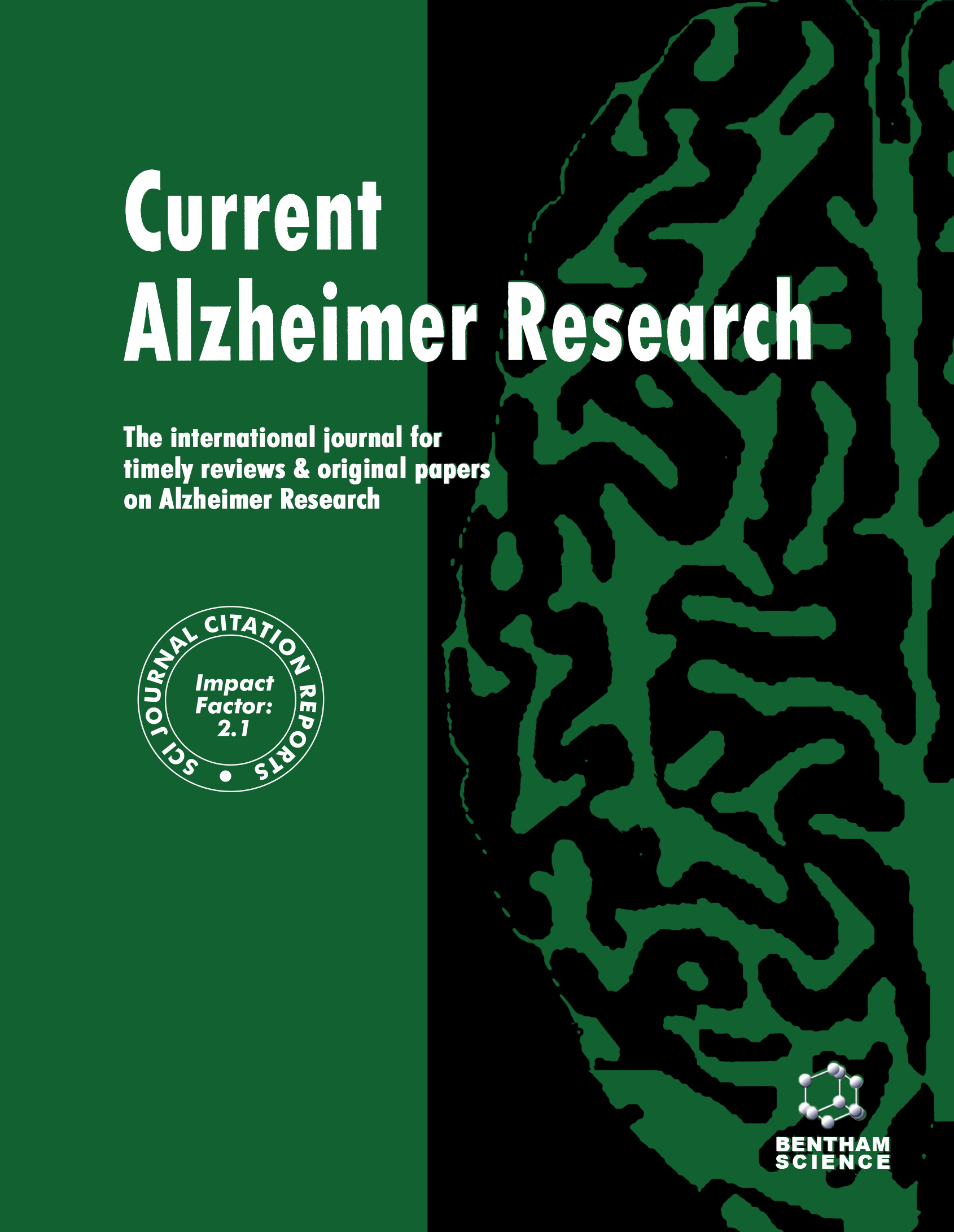- Home
- A-Z Publications
- Current Alzheimer Research
- Previous Issues
- Volume 17, Issue 10, 2020
Current Alzheimer Research - Volume 17, Issue 10, 2020
Volume 17, Issue 10, 2020
-
-
Degradation Products of Amyloid Protein: Are They The Culprits?
More LessAuthors: Dmitry V. Zaretsky and Maria ZaretskaiaObjectives: Beta-amyloid (Aβ) peptides are most toxic to cells in oligomeric form. It is commonly accepted that oligomers can form ion channels in cell membranes and allow calcium and other ions to enter cells. The activation of other mechanisms, such as apoptosis or lipid peroxidation, aggravates the toxicity, but it itself can result from the same initial point, that is, ion disturbance due to an increased permeability of me Read More
-
-
-
Statins, Risk of Death and Ischemic Stroke in Patients with Dementia: A Registry-Based Observational Cohort Study
More LessBackground: Survival in patients with dementia is variable. Statins are a cornerstone of cardiovascular prevention. However, the effect of statins on mortality and risk for stroke in patients with dementia is not clear. Objective: The aim of the study was to analyse the association between the use of statins and the risk of all-cause death and first ischemic stroke in patients diagnosed with dementia. Methods: A longitudinal cohort st Read More
-
-
-
Elucidating the Risk Factors for Progression from Amyloid-Negative Amnestic Mild Cognitive Impairment to Dementia
More LessAuthors: Hyung-Ji Kim, Jae-Hong Lee, E-nae Cheong, Sung-Eun Chung, Sungyang Jo, Woo-Hyun Shim and Yun J. HongBackground: Amyloid PET allows for the assessment of amyloid β status in the brain, distinguishing true Alzheimer's disease from Alzheimer's disease-mimicking conditions. Around 15-20% of patients with clinically probable Alzheimer's disease have been found to have no significant Alzheimer's pathology on amyloid PET. However, a limited number of studies had been conducted on this subpopulation in terms of clinic Read More
-
-
-
Volumetric MRI demonstrates atrophy of the olfactory cortex in AD
More LessObjective: Alzheimer disease (AD) is a chronic neurodegenerative disorder that affects millions of individuals worldwide. Symptoms include memory dysfunction and deficits in attention, planning, language, and overall cognitive function. Olfactory dysfunction is a common symptom of AD and evidence supports that it is an early marker. Furthermore, olfactory bulb and entorhinal cortex atrophy are well described in AD. Howev Read More
-
-
-
Dihydroartemisinin Ameliorates Decreased Neuroplasticity-Associated Proteins and Excessive Neuronal Apoptosis in APP/PS1 Mice
More LessAuthors: Yueyang Zhao, Zhimin Long, Yuanjie Liu, Min Luo, Yu Qiu, Nur F.B. Idris, Aijia Song, Kejian Wang and Guiqiong HeBackground: Alzheimer's disease (AD) is one of the worst neurodegenerative disorders worldwide, with extracellular senile plaques (SP), subsequent intracellular neurofibrillary tangles (NFTs) and final neuron loss and synaptic dysfunction as the main pathological characteristics. Excessive apoptosis is the main cause of irreversible neuron loss. Thus, therapeutic intervention for these pathological features has been consider Read More
-
-
-
A Comprehensive Analysis of Unique and Recurrent Copy Number Variations in Alzheimer's Disease and its Related Disorders
More LessBackground: Copy number variations (CNVs) play an important role in the genetic etiology of various neurological disorders, including Alzheimer's disease (AD). Type 2 diabetes mellitus (T2DM) and major depressive disorder (MDD) were shown to have share mechanisms and signaling pathways with AD. Objective: We aimed to assess CNVs regions that may harbor genes contributing to AD, T2DM, and MDD in 67 Saudi familial an Read More
-
-
-
Directed Network Defects in Alzheimer's Disease Using Granger Causality and Graph Theory
More LessBackground: Few works studied the directed whole-brain interaction between different brain regions of Alzheimer's disease (AD). Here, we investigated the whole-brain effective connectivity and studied the graph metrics associated with AD. Methods: Large-scale Granger causality analysis was conducted to explore abnormal whole-brain effective connectivity of patients with AD. Moreover, graph-theoretical metrics Read More
-
-
-
Different Morphology of Neuritic Plaques in the Archicortex of Alzheimer's Disease with Comorbid Synucleinopathy: A Pilot Study
More LessAuthors: Nikol Jankovska, Tomas Olejar, Jaromir Kukal and Radoslav MatejBackground: Bulbous neuritic changes in neuritic plaques have already been described, and their possible effect on the clinical course of the disease has been discussed. Objective: In our study, we focused on the location and density of these structures in patients with only Alzheimer's disease (AD) and patients with AD in comorbidity with synucleinopathies. Methods: Utilizing immunohistochemistry and confocal microsc Read More
-
Volumes & issues
-
Volume 21 (2024)
-
Volume 20 (2023)
-
Volume 19 (2022)
-
Volume 18 (2021)
-
Volume 17 (2020)
-
Volume 16 (2019)
-
Volume 15 (2018)
-
Volume 14 (2017)
-
Volume 13 (2016)
-
Volume 12 (2015)
-
Volume 11 (2014)
-
Volume 10 (2013)
-
Volume 9 (2012)
-
Volume 8 (2011)
-
Volume 7 (2010)
-
Volume 6 (2009)
-
Volume 5 (2008)
-
Volume 4 (2007)
-
Volume 3 (2006)
-
Volume 2 (2005)
-
Volume 1 (2004)
Most Read This Month
Article
content/journals/car
Journal
10
5
false
en

Most Cited Most Cited RSS feed
-
-
Cognitive Reserve in Aging
Authors: A. M. Tucker and Y. Stern
-
- More Less

